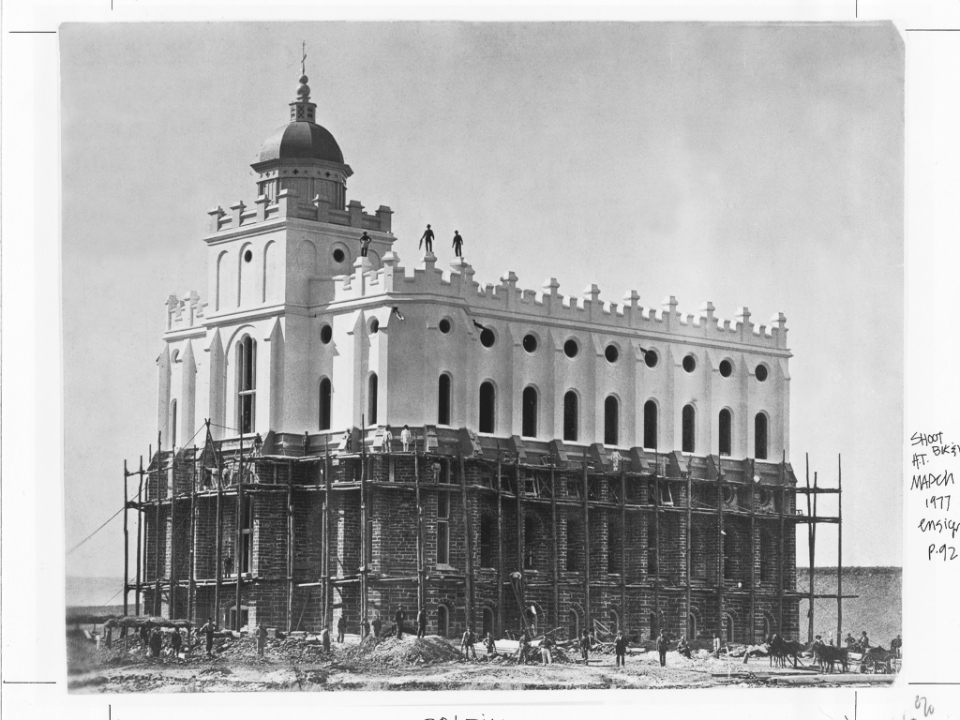
St.-George-Temple
A view of the St. George temple in the process of being stuccoed February 28, 1876. Standing on parapet are Aaron McDonald, Robert McQuarrie (with saw in hand) and George Laub (wearing apron).2023 by Intellectual Reserve, Inc. All rights reserved.This story appears here courtesy of TheChurchNews.com. It is not for use by other media.
By Rachel Sterzer Gibson, Church News
During the recent renovation of the historic St. George Utah Temple, construction crews discovered a time capsule in a small gap of one of the columns, placed by some of the original workers in 1876 — the year before the dedication in 1877.
Among items in the capsule was a poem written by Joseph Longking Townsend.
While some might not recognize Townsend’s name, they most likely are familiar with his work. In the current hymnbook, “The Day Dawn Is Breaking,” “Choose the Right,” “Hope of Israel” and “The Iron Rod” are among the compositions credited to him.
In summer 1876, 27-year-old Townsend left his store and pregnant wife in Payson, Utah, to offer his time and effort to the temple construction.
The poem he left encapsulated in St. George reads:
“Whatever be my failings and desires
“To Thee O Lord my heart be firm and true
“Thy law my law. Whatever God requires
“This be my hope His loving will to do.
“And whatsoever I love with act or breath
“If I should love Thee less than how I can
“Remember me O Lord in life or death
“As one that ever loves his fellow man.”
J L Townsend
July 14 1876
St Geo Temple
Emily Utt, the Church’s historic sites curator, noted that Townsend placed his poem in the column on July 14, 1876 — just a day after his first child was born.
Townsend’s poem — as well as his sacrifice to leave his business and his family — are representative of the faith and consecration demonstrated by thousands of Latter-day Saints who built and served in this house of the Lord in the desert.
On Sunday, December 10, President Jeffrey R. Holland, Acting President of the Quorum of the Twelve Apostles, will rededicate the historic structure — a temple Utt said was “built by the unsung heroes of the Church.”
For Utt, the story of the St. George Utah Temple is really the story of “common, everyday people who have made a choice to give their all to the kingdom of God. They build something that is beautiful and holy, not because it’s fancy, but because it represents the very best of who they are.”
Why the Temple Was Important for St. George
Just two years after President Brigham Young and fellow members of The Church of Jesus Christ of Latter-day Saints arrived in the Salt Lake Valley, Apostle Parley P. Pratt traveled to what is now the southern part of Utah in 1849. Pratt described volcanic forms and a place “where life does not seem to exist,” Utt said.
Church President Brigham Young, however, was focused on creating Zion and for the Saints to take care of everything they needed. “[Brigham Young] has his eyes set on southern Utah as a place where the Saints could grow cotton and other warm-weather crops so they don’t have to rely on materials from the East,” Utt explained.
In the mid-1850s, the first families were sent to settle there. Most who went “were not enthusiastic about it,” said Matthew Godfrey, senior managing historian for outreach and engagement in the Church History Department.
Many pioneers had traveled from Europe and had already worked to establish farms. They did not want to leave their homes and start over yet again in a formidable landscape.
Yet, they went. “And it was about as difficult as it could be,” Utt said. The area was hot, dry, dusty and barren. Settlers had to contend with flooding from the Virgin River, which brought swarms of mosquitoes and biting insects and disease.
“People had a lot of reasons to leave and almost no reasons to stay,” Utt said.
Of those originally called to settle there, only about half remained, Godfrey said. But those who stayed were hardy and stalwart. “I think those who stayed really were some of the greatest pioneers that we had from that generation,” Godfrey said. They sincerely wanted to do what the Lord and their leaders asked them to do.
Even so, by 1871 the settlement was still struggling. “Things were still not looking good,” Utt said. But in January of that year, Brigham Young announced a temple for the area.
Why would the Prophet ask the Saints there to sacrifice even more to build a temple when they were already overwhelmed with carving out a community?
“I think Brigham Young foresaw that perhaps having kind of a public works project down there would help unite the people,” said Godfrey. “It would prove to be an economic boon and kind of facilitate the establishment of St. George.”
With so many going and leaving, “the temple gives them a motivation to stay,” Utt added. “They’re not going to build a holy place and then leave. … It’s also a great unifying idea of ‘let’s build something to God in the desert in the wilderness.’”
Utt said Brigham Young’s announcement also showed the Prophet’s trust in the southern Utah members. “These are his friends. He loves them, and he wants them to succeed and enjoy those blessings. I think he also picked St. George because he knows that these are people that will work hard to build Zion. They’re not going to give up when things get difficult.”
Instead of being daunted by the undertaking, the Saints rejoiced. Godfrey shared that when Erastus Snow, the Apostle sent to lead the Church in southern Utah, heard the announcement, he shouted, “Glory hallelujah!”
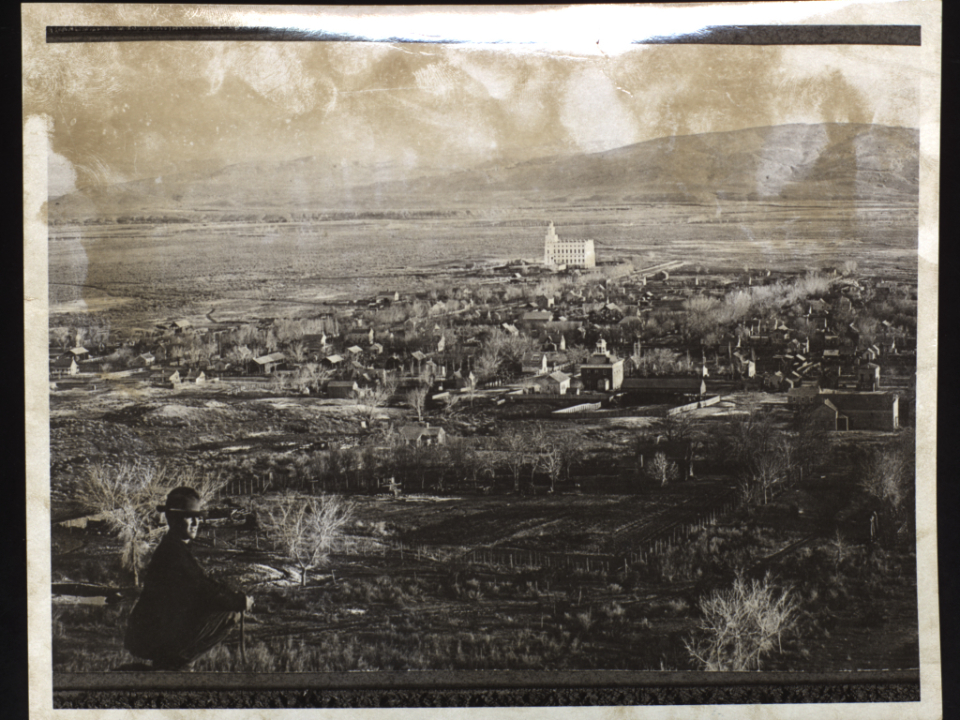
St.-George-Temple
The St. George Utah Temple circa 1890.2023 by Intellectual Reserve, Inc. All rights reserved.Why the St. George Temple Was Important to the Church
Before Joseph Smith died, he taught Brigham Young the endowment ceremony. “He said, ‘Brother Brigham, this is not arranged right, but we have done the best we could under the circumstances in which we were placed.’ And Joseph then told Brigham Young to take the matter in hand and organize and systematize all the [temple ceremonies],” Godfrey said.
According to Apostle Orson Hyde, before Joseph Smith’s death, he met with the Apostles and conferred upon them all of the keys of the priesthood.
“We sometimes think that those keys are just the keys to administer the Church,” Godfrey said, “but one of the important aspects of those keys were … to administer temple ordinances. And Joseph Smith very much wanted to make sure that those keys remained on the earth so that the Saints could have their temple blessings.”
After the martyrdom of Joseph Smith, with the Saints driven out of Nauvoo, Illinois, and cut off from their temple, “Brigham Young knew that he was going to have to continue that prophetic purpose to build temples,” noted Benjamin Pykles, director of the Church History Department’s Historic Sites Division.
Shortly after arriving in the Salt Lake Valley, President Young located a temple site, but construction of the Salt Lake Temple took a long time. By 1871 — when Brigham Young announced a temple for St. George, Utah — the Prophet’s health was declining, and he was starting to realize the importance of passing on the information about ordinances and temples. But he needed a place to do it, explained Pykles.
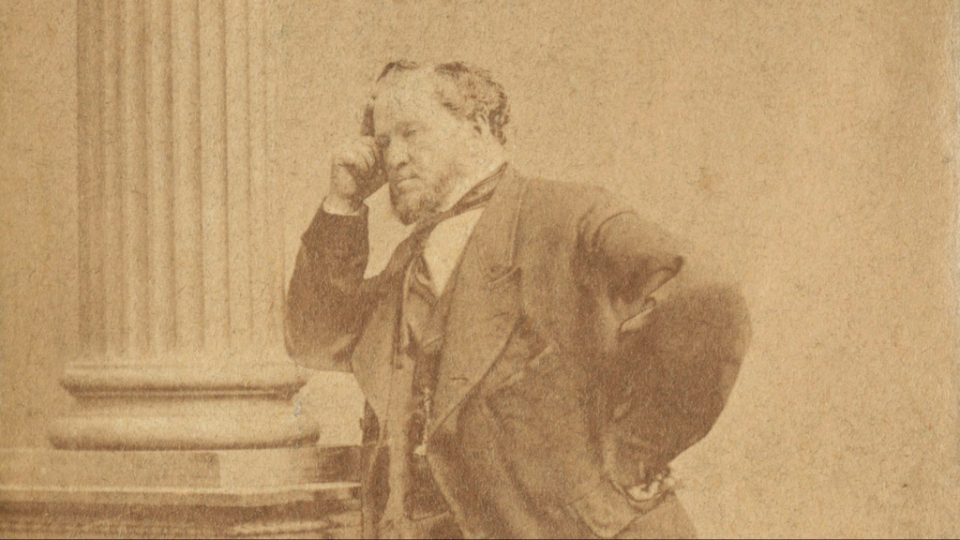
St.-George-Temple
An image of Brigham Young during his years as the President of The Church of Jesus Christ of Latter-day Saints.2023 by Intellectual Reserve, Inc. All rights reserved.At that time, the Saints had the Endowment House, where they could receive their own ordinances. “But Brigham Young did not believe that ordinances for the dead should be performed in the Endowment House,” Godfrey said.
Also, prior to dedication of the St. George temple, the endowment ceremony was only communicated orally. President Young, foreseeing that there would be more temples constructed, wanted to make sure the ordinances were written and standardized for subsequent temples.
Building the St. George Temple
From announcement in January 1871 to completion in April 1877, construction of the St. George temple in six years is miraculous, even by modern standards, noted Utt. “For these people in St. George and the community, the consecration required is really remarkable.”
One of the things that makes it even more noteworthy is the temple “was literally built from the scenes of the town,” Utt said. At the time, the railroad did not extend to southern Utah. With the exception of the windows and some of the metal features — such as the baptismal font — all of the building materials came from within a few miles of the temple site.
The stone for the foundation and the stones for the walls came from quarries within a mile and a half of the temple site. The wood for the interior finishes came from Pine Valley on nearby Mount Trumbull. To get the materials to the temple site, the Saints had to build a road and a sawmill.
The location for the temple was marshy, and the Saints worried it wouldn’t support a large building. Before laying the foundation, the Saints hauled in black volcanic rock from the surrounding area. Using a cannon as a makeshift pile driver, they raised the cannon in the air and then dropped it to pound the volcanic rock into the ground.
If they dropped the cannon and it bounced three times, they knew the ground was stable enough for the foundation, Godfrey explained.
After spending two years stabilizing the foundation, they laid the cornerstone for the temple in March 1873.
Although hot in the summer, one of the advantages of St. George’s climate was the ability to work on the temple year-round. Many farmers from northern Utah would come to work on the temple during winter months before returning to their farms for planting season in the spring, Godfrey said.
Members of the Church from all over the Utah Territory were sent on missions to help raise money for the temple fund. Workers came from surrounding settlements to help with construction. “It really was a united effort by the entire Church,” Utt said.
As the temple neared completion, President Young commissioned and paid for the baptismal font, which was cast at a foundry in Salt Lake City and hauled by wagon to St. George.
As it was being installed, Elder Hyde left the scene weeping. “He thanked God that he had lived to see another font in place in a temple of the Lord,” (“How the Temple Font Was Taken to St. George,” Deseret News, August 29, 1931).
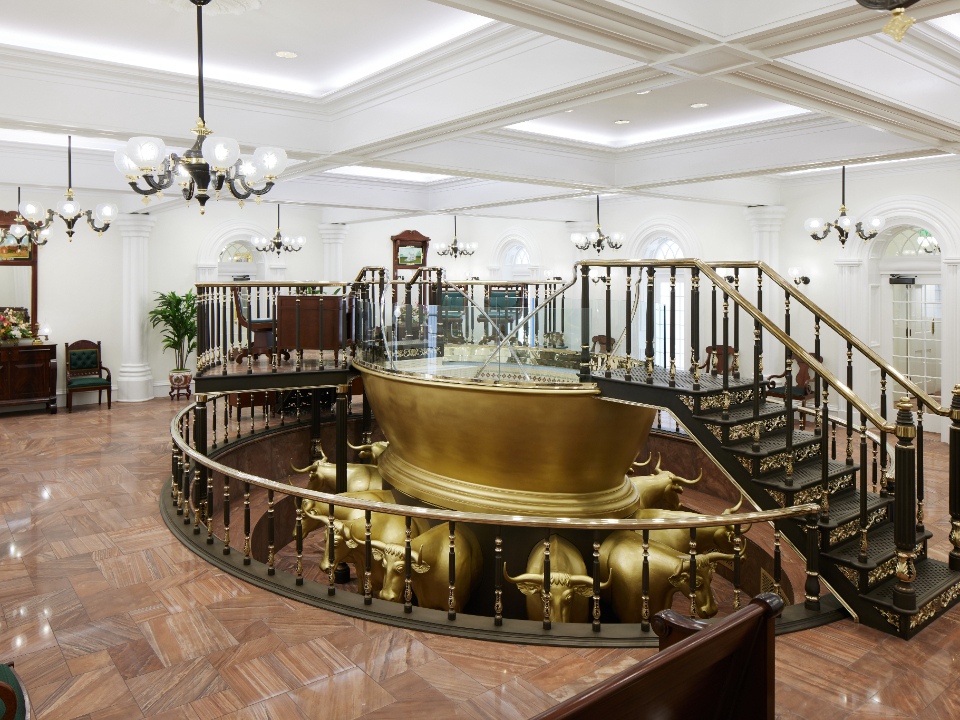
St.-George-Temple
The baptistry of the St. George Utah Temple.2023 by Intellectual Reserve, Inc. All rights reserved.The Original Dedication of the St. George Temple
Close to 30 years after being driven from their temple in Nauvoo, the Saints completed the St. George Utah Temple in its entirety April 6, 1877, during the Church’s three-day general conference. It became the first temple in Utah as well as the first house of the Lord where the endowment and sealing ordinances were performed by proxy for deceased ancestors. It was also where the first written record of the ordinances and ceremonies were made.
But sections of the temple were previously dedicated in phases as construction was completed.
“The Saints were so excited to begin temple work they didn’t want to wait a minute longer than necessary,” explained Utt.
The first dedication was January 1, 1877, when Wilford Woodruff, then an Apostle, dedicated the font. Elder Erastus Snow dedicated the assembly room, which was then used for the endowment ceremony.
President Young’s son, Apostle Brigham Young Jr., dedicated the sealing room. The first baptisms for the dead were performed January 9, 1877, and endowments began January 11, 1877 — all while construction continued in other areas of the temple.
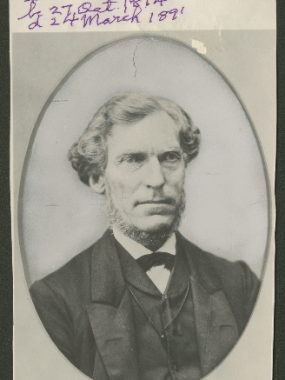
St.-George-Temple
A photo of Daniel H. Wells.2023 by Intellectual Reserve, Inc. All rights reserved.The prayer to dedicate the entire structure was offered by President Daniel H. Wells, Second Counselor in the First Presidency, during the opening session of the April 1877 general conference.
Prior to the dedication, the First Presidency printed in the Deseret News “A Word of Counsel to the Latter-day Saints Concerning the Conference at St. George” where they noted that the temple would only accommodate about one-sixth of the seating found in the Salt Lake Tabernacle. They also noted the limited hay and grain available in the vicinity. As such, they advised those who wished to attend to bring their own horse feed and tents or other conveniences for camping.
“The citizens of St. George will no doubt, to the fullest extent, manifest the proverbial hospitality of the Latter-day Saints, but at the same time, as there are no empty houses, all they can do will be but to share their house room with the many who will come,” the notice said (Deseret News, March 14, 1877).
A newspaper from the time, the Herald Republican, reported that roughly 5,000 gathered in the main hall of the temple, with more than 200 carriages and other wheeled vehicles parked outside the gates.
The occasion brought the entire First Presidency and all of the members of the Quorum of the Twelve Apostles in the territory, as well as the Presiding Bishopric and the local bishops from surrounding settlements.
The Beaver brass band and choirs from Beaver, Parowan and St. George provided the music for the three-day conference or, as noted in the Herald Republican article, “assisted in the musical worship.”
The weather was nice until the close of the conference, when “it blew quite a hurricane, causing a momentary demoralization of bonnets, hats, wagon covers, etc.” (“The St. George Conference,” Herald Republican, April 15, 1877).
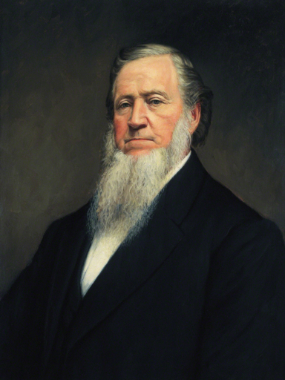
St.-George-Temple
Brigham Young, governor of the Utah Territory and president of The Church of Jesus Christ of Latter-day Saints.2023 by Intellectual Reserve, Inc. All rights reserved.Leading up to the dedication, President Young’s health had been deteriorating. Sources suggest that he had to be carried about the temple and up the spiral staircase in a chair, Utt said.
Despite this, the Prophet spoke each day of the conference and “seemed more robust and vigorous than we have for a long time seen him in public,” the newspaper said.
In his discourse of the first day, President Young said, “As to my health I feel many times that I could not live an hour longer, but I mean to live just as long as I can. I know not how soon the messenger will call for me but I calculate to die in the harness.”
Many of the speakers for the conference expressed gratitude for the privilege of worshipping again in a temple of God.
Elder Brigham Young Jr., for example, spoke of the privilege of meeting together in the first temple “to be erected by the Latter-day Saints in these mountains. This privilege was one which had been looked forward to with earnest and prayerful aspirations by the people of God who had been gathered. This holy habitation erected to the name of the Most High God was a beautiful and forcible illustration of the union which existed among us” (Deseret Morning News, April 9, 1877).
Among the attendees that day was a Latter-day Saint named David Milne, who was a decorative painter for the temple. Utt explained that it was common practice at the time for missionaries to be called on missions during general conference. As Mills was sitting in the room of the building he probably finished the day before, he heard his name called to serve a mission to Europe.
“And he goes because he has promised to give his all to the kingdom,” Utt said.
In offering the benediction for the three-day conference, President Young prayed that Heavenly Father “will let His Spirit rest upon this house, that His angels may visit it, and His Spirit rest upon those who shall come into this house to labor for themselves or for their dead friends, that they may feel its influence.”
Roughly four months after the dedication, on August 29, 1877, President Young died in Salt Lake City at the age of 76.
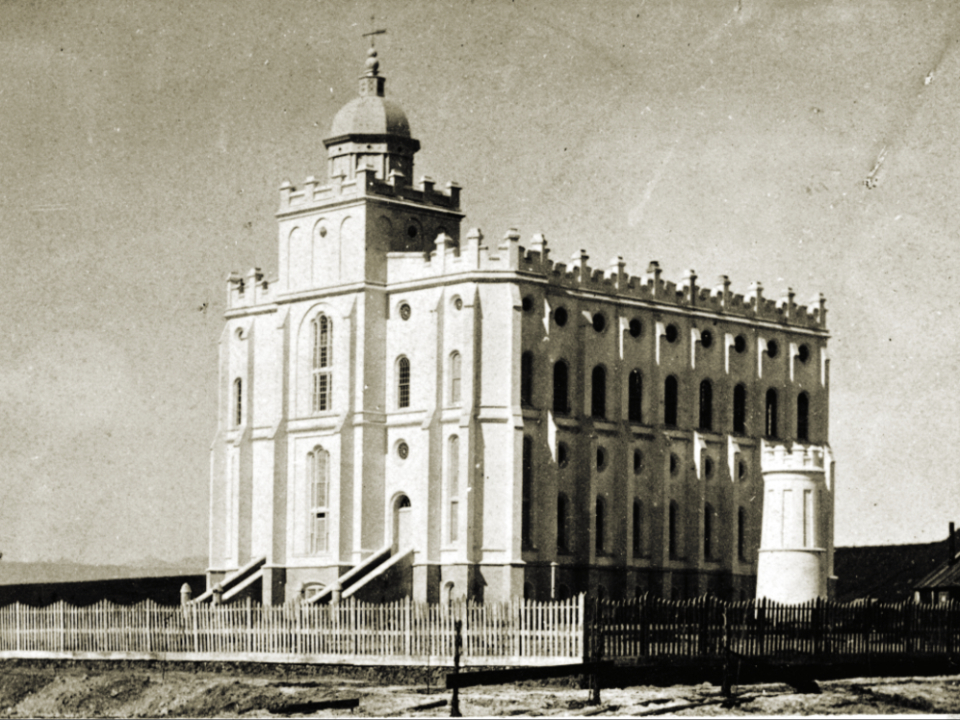
St.-George-Temple
The St. George Utah Temple circa 1877.2023 by Intellectual Reserve, Inc. All rights reserved.Legacy of the St. George Temple
Wilford Woodruff, who was “an incredible diary keeper” and served as the first president of the temple, recorded that in the first year roughly 25,000 baptismal ordinances were performed as well as 12,000 endowments and 3,800 sealing ordinances — an impressive number considering the population of St. George was fewer than 1,500. “It just shows how excited the Saints were and how readily they went and started performing these ordinances for the dead,” Godfrey said.
Temporally, the temple brought many blessings. The work that the Church did on the St. George Tabernacle and temple established necessary infrastructure, industries and businesses — such as roads, mills and craft shops — that continued to operate once the buildings were completed. “There were still challenges that the settlers had with flooding, etc., but for the most part, the communities were now well established and would not be abandoned,” Godfrey said.
The dedication of the St. George temple was also the spark that set in motion a cascade of temple building in the latter days. Within 10 years, the Manti and Logan temples were dedicated as well as the Salt Lake Temple in 1893. Today there are 335 temples announced, under construction or operating.
Godfrey says for him, the St. George temple serves as a beacon of peace and holiness — a symbol of the Savior’s Atonement. Inside, he can feel the spirit of sacrifice and consecration of the Saints who built it.
Studying the history of the temple “is a wonderful reminder to me of how central the temple can be and should be in all of our lives,” Utt said.
The lives of individuals like Joseph Townsend, Brigham Young, Erastus Snow, Wilford Woodruff and David Milne are another “beautiful testimony of faith,” she said.



